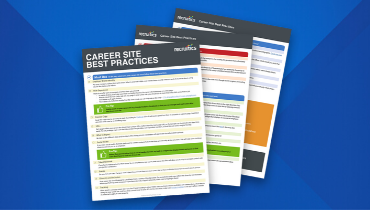Are you getting enough applications for your jobs? If you’re like most employers, the answer is a resounding no, and you’re googling for ways to improve your application flow. Perhaps the solution isn’t a new job board, social network or email blast, but rather something closer to home — your career site. When was the last time you redesigned your career website? If you are not getting enough qualified applicants for your jobs, consider a refresh and redesign with the candidate experience in mind.
In my previous roles as a recruitment marketing manager and later as a talent acquisition manager, I participated in two company career website redesigns. In my current role at KRT Marketing, I’m helping corporate talent acquisition teams define and evaluate career site platforms with a focus on design for candidate user experience (UX) and increasing visitor conversions (i.e. getting more applicants).
Based on this experience, I’ve prepared the following tips to keep in mind when you’re shopping for a new career site vendor, recruitment marketing platform or giving your existing career website a facelift. This is not meant to be an exhaustive list but offer several of the features that have helped increase applicant flow for multiple companies.
- Search engine-friendly URLs – Search engines read the URL as part of the indexing process. Make sure the career site platform can append the job title and location to every job posting. For example, your ATS may generate a URL that only includes the requisition number. The req number means nothing to search engines. You need your career platform to translate this …jobs/8175 into …/jobs/8175/US/MI/Detroit/teradata-edw-database-administrator. One critical differentiator between vendors is whether or not they can translate the location into the URL. Remember that most candidates search not only by skill or job title but by location as well.
- Your career site platform should offer customizable job alerts. But it needs to go beyond a button at the top or bottom of your career site home page. Buttons require taps or clicks and increase the chance of drop off. For optimum sign-ups, the job alert sign up needs to be a form (read: less clicks) that can be embedded on to pages. A good example of where you should see a job alert sign up is the job search results page. When candidates come up with 0 job results, the job alert form should be displayed.
- Another form that’s necessary for your career site is one to join the talent network (also known as a talent community). This form would be connected to your candidate relationship management (CRM) system. This should also be a standalone page in your career site with a unique URL. Promote this page throughout your content on the career site and on social media. Invite your recruiters to create a link in their signature.
- Make sure individual job postings and other career site pages have a unique URL that displays in the address bar. When the content of the page changes, so should the URL. If the URL doesn’t change, those job postings cannot be bookmarked or shared.
- Allow for multiple pixels (e.g. Google and Facebook) to be placed on pages for retargeting ads, also known as remarketing.
- I’m probably alone in this opinion but your career site does not need a featured jobs section. Nonetheless, many career site platforms have a module called “Featured Jobs” and some of them recommend placing this module on the career site home page above the fold for all to see. Recruiters mark a job to be posted as featured in their ATS when they are having a difficult time finding qualified applicants. This job now shows up on the homepage of your career site. And yes, it’s now going to potentially be seen by every visitor to your career site but whether that’s 100 or 100,000 people, what are the odds that those candidates live near that location and have the skills to do that job? Recruiters will get more applications, but will they be qualified? Additionally, this is the most valuable real estate on your career site so you should be including content that is engaging to every visitor (e.g. branding, culture, employee testimonials), not a job or couple of jobs that are only appealing to a small amount of visitors. Featured jobs are not helpful unless they can be contextualized for the visitor. Showing local jobs is much more relevant.
- Some career site platforms can track the location of your candidates. If you’re going to request users’ locations, do something useful with that information. Use that information to show jobs based on visitor’s IP address. Hacker tip: Learn the IP address of your competitors, and when someone visits your career site from that IP, serve customized content aimed at recruiting them away from your competitor.

- The main navigation for your career site shows up on every page and drives your candidates’ journey. Therefore, it’s important to create a logical syntax. It might seem obvious but some vendors offer career site templates that do not include a home button. It’s essential that the career site you design includes a home button in case candidates want to get back to the beginning and start their journey over. Make it obvious how to get back to the career site home page.
- Five years ago most companies didn’t have someone in-house that could build a web page aside from the IT department. Today, many more mid-range and large employers have an employment brand or recruitment marketing strategist with design experience and enough technical skills to build out a campaign landing page. Therefore, look for a career site platform that allows end users to build and publish their own page. Bonus point if the platform can handle approval requests.
- If you think about the candidate journey, most candidates will be referred to your job posting from a job board. You want content or a feature that will keep them on your career site versus going back to the job board to review a competitor’s job posting. Think about this suggestion in consumer terms. When you’re searching on Amazon, do you catch yourself scrolling through “Your recommendations” or “Sponsored products related to this item”? There are career site platforms that now offer an Amazon type experience to job seekers. Provide candidates a “Not a match for you?” feature like the one below at CH2M to get candidates to stay in your career site journey.

- Want to know what content is registering with your candidates? Some vendors can heat map your career site page and tell you not only which pages are getting viewed but what content on the page is being read.
- No matter what page you’re on in the career site, you should be no more than two clicks away from a job description and the apply button. Test your current career site – did it pass the test?
Download this CAREERS SITE BEST PRACTICES CHECKLIST
I hope these recommendations have helped you start preparing for a new and improved career site with increase applications. Career site taxonomy and user experience projects are two of my favorite activities at Recruitics. Please contact us if you’re interested in talking shop!
Happy hunting!




